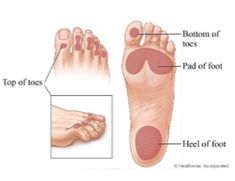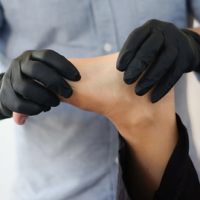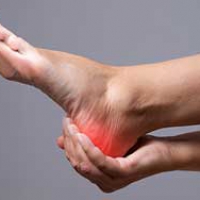Fungal Infection – Patient Information Sheet
What is fungus?
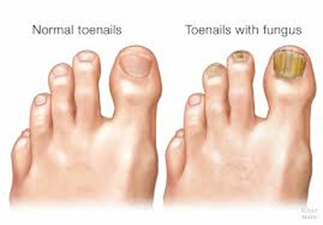 Fungus is a family of microorganisms that consists of dermatophytes, yeasts and moulds. These microorganisms live off of dead tissue from our skin, hair and nails and flourish in wet or humid conditions. Onychomycosis is a fungal infection of the nail
Fungus is a family of microorganisms that consists of dermatophytes, yeasts and moulds. These microorganisms live off of dead tissue from our skin, hair and nails and flourish in wet or humid conditions. Onychomycosis is a fungal infection of the nail
What does a fungal infection look like?
Skin Fungal Infection (Tinea Pedis): On the skin, fungal infections have different presentations. It can range from red spots or blister-looking vesicles on the instep/bottom of your foot (sometimes extending on the top of your foot) to scaly, dry fissures creating a moccasin-like distribution surrounding the base of your feet and heels. Fungal infections are also often found in between your toes resembling think white scaly skin, sometimes accompanied with redness. Fungal infections can cause your skin to be quite itchy.
Nail Fungal Infection (Onychomycosis): When fungus affects the nail, the nail can present with one or many of the following: yellow or white streaks, thickened nails, crumbly yellow or white debris underneath the nail, brittleness, lifting of the nail from the skin or change of shape.
How do you prevent a fungal infection?
- Make sure your feet are dried properly after a shower, especially in between your toes.
- If you tend to have sweaty feet, air out your shoes often and aim to get shoes and socks that are more breathable (ask a chiropodist for more details).
- Wash your feet and socks with soap and warm water.
- Avoid walking bare feet, especially in public areas such as swimming pools.
- If you go to a salon to get a pedicure, bring your own instruments and nail polish. Avoid using the same instruments that have been used on other people since fungal infections can be transmitted via direct contact.
A weak immune system, an existing nail deformity and/or poor feet hygiene increase your risk of getting a fungal infection.
Treatment options for fungal infection:
- Topical antifungal: topical antifungal creams, lotions or sprays can be prescribed by your chiropodist or found over the counter at your local pharmacy. Please follow the instructions given by your chiropodist in regards to its application. Make sure you wash your hands with soap and warm water before and after applying the topical anti-fungal. Topical antifungals are usually applied twice daily on the affected feet or nail for 2 to 4 weeks. An example of a topical anti-fungal is Lamisil (Terbinafine).
** There are also some anti-fungal powders available at pharmacies to help with fungal infections, especially affecting the interdigital area.
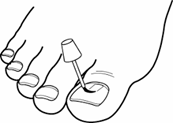
- Penlac nail lacquer for onychomycosis: Penlac is a nail lacquer containing 8% ciclopirox that can be applied each day to the affected nail like a nail polish. This medication has to be prescribed by a chiropodist. We recommend that the nail is thinned down by using a drill at a chiropody clinic or a nail file at home. A thin even layer of the nail lacquer should be applied once daily at bedtime on the affected nail. Let the lacquer dry for 30 seconds to 1 minute before putting your socks on. The following day, re-apply over the previous coat. After 1 week of application, the lacquer build-up must be removed from the nail with nail polish remover or rubbing alcohol. Continue the daily application protocol for 6 to 9 months.
** There is another nail solution that can be applied once daily for the treatment of onychomycosis. It is called Jublia. Ask your chiropodist or family doctor for more details.

- Total nail avulsion: in advanced or severe cases when the nail is completely deformed or the fungal infection is at risk of spreading into your blood circulation, we recommend surgically removing the nail. This short, simple procedure is called a total nail avulsion. The affected nail is removed to allow a new healthy nail to grow and take its place. In certain situations, we can also perform a matrixectomy to prevent your nail from growing back permanently. Ask your chiropodist for more information.
- Other alternatives: Lunula Laser treatments, Vicks Vaporub, Tea tree oil…Don’t hesitate to ask your chiropodist on the variety of treatment options out there for fungal infections!

